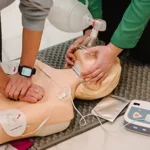Table of Contents:
- Introduction
- What Is Bradycardia?
- Symptoms of Bradycardia
- What Causes Bradycardia?
- Consequences of Bradycardia
- Diagnosis of Bradycardia
- Treatment Options for Bradycardia
- Lifestyle Modifications to Manage Bradycardia
- Sinus Bradycardia and AFib with Bradycardia
- Living with Bradycardia: Long-term Management
- Take Charge of Your Heart Health
Bradycardia is a condition in which the heart beats very slowly. Experts estimate the worldwide prevalence of bradycardia in the general population to be between 0.5% to 2.0%. A heartbeat frequency of 60-100 is within the normal range for most adults, whereas people with this disorder have a resting heart rate below 60 beats per minute.
The heartbeat is so low in such patients that it might lead to a number of symptoms and life-threatening complications. However, there are a few exceptions such as during deep sleep, your heart rate may plummet to less than 60 beats per minute. Besides, in physically active adults or athletes, it may often be less than 60 BPM.
In this article, we will define bradycardia medical term and discuss its symptoms, causes, and treatment options so that you can better understand the condition.
Get ACLS Certified in Minutes
Receive your ACLS Certification today!
What Is Bradycardia?
As per the bradycardia definition, bradycardia term derives from the Greek words ‘Bradys’, meaning slow, and ‘cardia,’ meaning heart. Thus, it refers to a heart rate that is slower than normal. Bradycardia is technically diagnosed when an individual’s resting heart rate is consistently below 50-60 beats per minute.
The electrical signal initiates each heartbeat in the normally functioning heart. It begins in a small region of tissue in the upper chamber of the heart called the sinoatrial node. This stimulates them to contract and then down to the atrioventricular node, which serves as a gate. This delay allows the atria to contract before the electrical impulse reaches the ventricles fully and they contract.
An irregularity in any part of the heart’s electrical circuit can cause bradycardia. This inefficiency forces the heart to beat too slowly. Thus, it possibly impairs the heart’s ability to pump enough blood to the rest of the body, thereby resulting in symptoms.
Symptoms of Bradycardia
The symptoms of bradycardia vary from one individual to another and range from mild to severe. Some people who have bradycardia do not show any apparent symptoms, especially when it is a mild condition. However, when the heart rate becomes progressively slower or more persistent, some of the following symptoms begin to appear:
- Fatigue or weakness,
- Dizziness or lightheadedness,
- Short breath while exercising or doing any other physical activity,
- Chest pain or discomfort,
- Confusion or difficulty concentrating,
- Fainting {syncope) or near-fainting episodes,
- Poor exercise performance,
- Feeling palpitations or sensing of missed or extra heartbeats.
Should you have the following symptoms, and they are more frequent or appear to have a serious impact on your daily activities, you should seek immediate attention from a doctor for proper check and diagnosis.
What Causes Bradycardia?
Several factors may cause bradycardia. However, two main causes of bradycardia are problems with the heart’s natural pacemaker, the sinoatrial node, and issues with the heart’s electrical conduction system. Among the common causes of bradycardia in adults are the following:
- Aging: Increased age is the most common risk factor associated with developing bradycardia, as according to studies, approximately 75-80% of pacemaker implants are done in people over the age of 65.
- Heart Tissue Damage: Damage to the heart tissue can occur due to a heart attack or heart disease, which will damage the electrical system of the heart.
- Hypothyroidism: An underactive thyroid gland causes diminished functioning of many body systems and slows the heart rate.
- Electrolyte Imbalance: Too little or too much potassium, calcium, or other electrolytes also disturb heartbeats.
- Medications: Beta-blockers, calcium channel blockers, and even some medicines used to treat irregular heart rhythms cause bradycardia.
- Sleep Apnea: This sleep disorder is also one of the bradycardia causes.
- Inflammatory Diseases: It can be lupus or even rheumatoid arthritis, which can rarely affect the electrical system controlling the heart.
- Congenital Heart Defects: Some people are born with heart defects that can lead to bradycardia.
- Infections: Some infections may cause bradycardia. For example, Lyme disease and endocarditis.
- Severe Hypothermia: A very low body temperature will slow down the heart rate.
Consequences of Bradycardia
Is bradycardia dangerous? Again, the answer is multifaceted and depends on various factors, such as the degree or severity of the bradycardia, its etiology, and whether or not the condition has caused any symptoms.
This may be normal and not a cause of concern in some cases, particularly in well-trained athletes or during sleep. However, bradycardia can become dangerous when the heartbeat becomes so slow that it cannot effectively pump enough blood to the vital organs of the body. Possible complications of untreated symptomatic bradycardia include:
- Frequent fainting spells
- Shortness of breath and decreased ability to exercise
- Chronic fatigue and weakness
- Increased risk of falls, especially in older adults
- Possibility of sudden cardiac death in severe cases
Read more: Learn the basic difference between a cardiac arrest and a heart attack (aclsnow.com)
Diagnosis of Bradycardia
Bradycardia is most commonly diagnosed by considering case history, physical examination, and diagnostic studies. Your cardiologist will assess the following for diagnosing your condition:
- Electrocardiogram: An electrocardiogram or ECG records the electrical activity of the human heart and will let doctors diagnose bradycardia and other rhythm abnormalities.
- Holter Monitor: This portable device records a person’s heart activity over 24 to 48 hours.
- Event Recorder: A small wearable device designed to record heart rhythm upon activation when symptoms are experienced.
- Echocardiogram: This is an ultrasound picture of the heart, which may reveal structural abnormalities or damage.
- Exercise Stress Test: This test measures your heart rate and rhythm while you are physically active. Blood tests may also reveal electrolyte imbalances, an underactive thyroid, and other conditions that could contribute to bradycardia.
- Tilt Table Test: This test is performed if physicians believe that bradycardia might be the cause of fainting spells.
Treatment Options for Bradycardia
Treatment for bradycardia varies based on the cause, severity, and associated symptoms. In some cases, mainly when bradycardia is asymptomatic and of a minor nature, it may not be necessary to treat it. However, for symptomatic or severe cases, there exist varieties of bradycardia treatments as follows:
- Treat the Underlying Conditions: Treating other underlying health problems that can cause bradycardia, such as hypothyroidism or sleep apnea, could relieve the slow heart rate.
- Medication Changes: If medications cause bradycardia, your doctor adjusts their dosages or prescribes alternative drugs.
- Pacemaker: If bradycardia is more severe or persistent, your doctor may suggest installing a pacemaker. A pacemaker is a small electronic device that is surgically implanted in your body; it helps regulate your heart rate.
- Atropine: In emergencies, healthcare providers can administer this medication to the patient to raise the heart rate temporarily.
- Lifestyle Changes: Many times, bradycardia can be treated by lifestyle changes that relieve the symptoms of the condition.
Thus, the choice of bradycardia treatment will depend on individual factors and must be thoroughly discussed with a healthcare provider.
Read More: ACLS Bradycardia: Understanding the Role of Drugs & Guidelines (aclsnow.com)
Lifestyle Modifications to Manage Bradycardia
After understanding what bradycardia is, you must know the strategies to manage the condition. While medical treatments are often necessary for managing bradycardia, there exist certain lifestyle modifications that can also help in its management. These include:
- Regular Exercise: Engage in physician-approved physical activities to make your heart strong.
- Stress Reduction: Practice stress-management techniques like meditation or yoga.
- Healthy Diet: Consume a balanced diet rich in fruits, vegetables, and whole grains.
- Hydrate: Stay hydrated to maintain good blood flow.
- Avoid Triggers: Avoid those factors that you think can trigger your symptoms.
- Sleep Hygiene: Get enough and good quality sleep every night.
- Avoid Alcohol And Caffeine: These are some of the substances that alter heart rhythm.
However, before making major changes in your lifestyle, especially about the diagnosis of bradycardia, consult with your doctor.
Sinus Bradycardia and AFib with Bradycardia
Two specific types of bradycardia that people must be aware of are:
- Sinus Bradycardia: This occurs when the heart’s natural pacemaker—the sinoatrial node—fires at a rate of less than 60 beats per minute. Sinus bradycardia is normal in athletes or during sleep but may indicate a problem if symptoms occur.
- Atrial Fibrillation with Bradycardia: AFib bradycardia is a condition in which the atria contract very fast and irregularly and the ventricles, very slowly. This can be a challenging combination and may call for special treatment methods.
You must seek immediate medical attention if you have recurring episodes of the following:
- Recurrent fainting or near-fainting
- Severe difficulty breathing
- Chest pain or discomfort
- Persistent, unexplained fatigue or weakness
- Confusion, mental fogginess, or concentration problems
If you have already been diagnosed with sinus bradycardia, be sure to keep follow-up appointments with your doctor for ongoing care and monitoring.
Living with Bradycardia: Long-term Management
For patients who have a diagnosis of chronic bradycardia, long-term care is essential for maintaining good quality of life. This may include:
- Regular medical check-ups
- Following prescribed treatments
- Monitoring the heart rate and symptoms over time
- Making lifestyle changes as recommended by your healthcare provider
- Coping emotionally and with stress
- Taking care of other health conditions
You can also consider enrolling in a course to learn about stroke management and how to respond to situations in which an affected individual has conditions like bradycardia or tachycardia.
Take Charge of Your Heart Health!
Bradycardia can be anything from an absolutely harmless condition to a dangerous health problem. Learning the bradycardia definition, symptoms, and causes is the key to handling the situation correctly. If you suspect that you have bradycardia or are experiencing symptoms associated with a very slow heart rate, don’t hesitate to seek medical evaluation. With proper diagnosis and treatment, most people with bradycardia can lead normal, active lives.
Your heart health is in your hands. With a proper diagnosis of bradycardia, you can maintain a healthy heart and lead a good life by collaborating closely with health providers, and adopting heart-healthy lifestyle habits.







